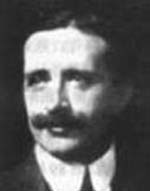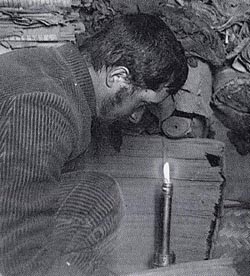Personnes
Paul Pelliot
28 May 1878 (Paris) - 26 Oct 1945 (Paris)
Pelliot, an unequaled acquirer of languages and an incomparable bibliographer, was trained in Sinology but devoted his chief attention to the Inner Asian side of China.
He first aspired to a career in the foreign service, and to that end took up the study of Chinese at the École des Langues Orientales Vivantes. There he attracted the attention of Chavannes and Levi, who encouraged him in a more scholarly direction. He came to Hanoi in 1900 as a research scholar with the École Française d'Extrême-Orient, and from there was sent to Peking to purchase books for the school. There he encountered the Boxer Rebellion, and was trapped in the Siege of the Legations (15 July - 15 August). He distinguished himself for both bravery and savoir-faire. Lionel Giles recalled one key incident this way:
A Frenchman, name Pelliot, went up to the Chinese barricade in Legation Street and had some tea with the soldiers. The Chinese asked him to go over to their barricade and see their Colonel, one Ma. This he did . . . There he had a talk with some blue-buttoned officials, who have him food, and tried to 'pump' him as to the state of our defenses and amount of provisions. He seems to have lied beautifully, making us out to be in a splendid way altogether.
After returning to Hanoi in 1901, he received the Cross of the Legion on Honor for this and other exploits during the siege. He was presently made a Professor at the École, and for several years divided his time between studying in Hanoi and acquiring books in China. His first scholarly note, which appeared in the Bulletin of the École for 1902, already displayed the erudite and critical posture which were to be his signature in the world of scholarship.
He returned to France in 1904 to represent the École at the 14th International Congress of Orientalists to be held in Algiers in 1905; while there, he was chosen to direct an archaeological mission to Chinese Turkestan. On 15 June 1906 he set out from Paris with a geographer and a photographer, and finally arrived at Peking in December 1910. On the way, the expedition had done useful work at several archaeological sites, but its high point was a stay of three weeks at a site already known from the 1907 visit of Aurel Stein: the huge manuscript trove of the Cave of the Thousand Buddhas in Dunhwang. Stein had made purchases from these riches, which are now the nucleus of the British Museum collection. Pelliot, arriving later but with an incomparably greater knowledge of Buddhism and of Chinese tradition generally, and with an almost photographic memory, was able to make much more discerning selections.
These are now the core of the Collection Pelliot in the Bibliothèque Nationale and the Musée Guimet of Paris. One item which he then overlooked, but later translated in collaboration with Edouard Chavannes from a facsimile of the Chinese text published by Lwo Jvn-yw, was a long Manichean Treatise on the Light. Pelliot, like most French Sinologues of the 20th century, was much concerned with the history of religion. Among his Dunhwang purchases were some Buddhist texts in Sogdian, including the Sutra of Cause and Effect, whose publication gave a great impetus to Iranian studies, and laid the foundation for the study of Sogdian grammar by Gauthiot and Emile Benveniste. Pelliot was one of the first scholars to realize the enormous importance of Middle Iranian languages, especially of Sogdian, in the transmission of religions and cultural motifs between Iran and Chinese Central Asia. His 1912 article (based on his Collège de France inaugural lecture of 1911) on Iranian influence on Central Asia remains a starting point for research on that subject.
The expedition had shaped him permanently, and his work would remain focused on Inner Asia, which he himself called his "terre d'election." He subsequently acquired documents, and personal competence, in Mongolian, Turkic, Arabic, Persian, Tibetan, and Sanskrit. His chair at the Collège de France, created especially for him in 1911, was in Central Asian Languages, and his most distinguished students (Ligeti, Cleaves, Hambis, Rolf Stein, Bazin, and SInor) have made their careers in that field. To their work with Pelliot, these people brought an acquaintance with things that Pelliot did not himself know, but was glad to learn. His vast competence in Chinese continued to serve as the fulcrum and intellectual unification point for these other efforts, but in that field, he had no students. He tended to regard them as interlopers, necessarily with inferior knowledge, in his own domain.
Pelliot served in China as a military attaché during WW1, and took part in a French expedition to Siberia. Following the War, he was active in the Société Asiatique, and in 1920 succeeded Chavannes as co-editor (with Henri Cordier) of T'oung Pao, a position of great power in European Sinology. In TP and in JA he was to publish much of his subsequent huge, if also diffuse, output of articles and reviews. In these pieces, which were often responses to the slipshod work of others rather than coming from an impetus of his own, he enforced high standards of bibliographic, textual, and linguistic competence. Hellmut Wilhelm put it in a phrase: he served from 1920 until his death as "the Policeman of Sinology." Among his most famous police actions was the banishing of von Zach from the pages of T'oung Pao in 1929:
M E von Zach s'est déconsidéré comme savant par ses balourdises. M E von Zach s'est disqualifié comme homme par ses grossièretés. Il ne sera plus question de M E von Zach dans le T'oung Pao.
Policemen also direct traffic, and Pelliot's observations frequently suggested topics which might be profitably examined by others. Cordier died in 1924, and Pelliot carried on alone as editor of TP until joined by Duyvendak in 1932, recreating the original Franco-Dutch character of the journal, a character which persists to this day.
Here is how Denis Sinor recalls his first exposure to Chinese under Pelliot, in 1939:
In his courses intended for his students, he paid no consideration whatever to the level of knowledge we may have had. I vividly remember the occasion when, in opening a course, he announced that it would be based on the Kirghiz chapter of the T'ang Shu. The fact that some of the handful of auditors (including myself) could not read Chinese did not bother him. By the time of the next lesson I had learned, on my own, how to use a Chinese dictionary, and had gained a vague idea of the contents of the first few lines of the text, to which he added his superb commentaries, veritable dazzling fireworks.
The dictionary in question, Sinor later revealed to the present writer, was that of Giles.
During the German occupation of Paris (1940-1944), under narrowing skies (TP ceased publication in 1942, not to resume until 1947), Pelliot continued his researches. He was French to the core, but had been too old to be conscripted for the war effort, and remained too proud to take a subordinate role in the ongoing but surreptitious Resistance. He limited himself to frosty contempt for the Vichy capitulation government, and in a celebrated incident, refused to shake the hand of a Vichy minister. Nor would he request official permission for the meetings of the Société Asiatique, which were therefore technically illegal during the occupation, a fact which nobody ever brought to the attention of the authorities. After the liberation of Paris, Pelliot made a brief visit to the USA, and died soon after his return.
Shortly before, he had characterized the recently deceased Maspero as "l'homme de la Chine Antique," a somewhat disdainful epitome for his intellectually more concentrated colleague and rival. Pelliot's own work spread geographically wider, and it has left an indelible imprint on the scholarship of the areas of overlap between Latin, Arabic, Persian, Mongol, and Chinese texts and their cultures. If wider, it was also shallower. His translation of the Secret History of the Mongols (judged by both Poppe and Sinor to be inferior to that of Haenisch) was never published in his lifetime. As Sinor notes,
. . . he could never bring himself to write a synthesis. Pelliot was certainly no historian, and lacked the essential virtue necessary for such a vocation: he was unable, or unwilling, to distinguish between the important and the unimportant.
He was parasitic. His own longer publications were largely responses to, or annotations on, or refutations and developments of, the work of others. An attempt was made to issue his unpublished papers as a series of books, under the chief editorship of his ranking disciple, Louis Hambis, but this broke down after several volumes. The notes did not in the end amount to books. His chief contribution to Altaic linguistics, a Festschrift paper on Mongol words with h- initial, was in form a seventy-page elaboration of an idea of Ramstedt, which had been published in an article of only five pages, 13 years earlier in Journal Asiatique. Pelliot was irretrievably a miniaturist and opportunist. In chess terms, he preferred to play Black, responding to the first moves of others with bibliographic control. His student Denis Sinor once asked him, hesitantly, and addressing him with the necessary "Maître," why he used his fantastic knowledge "only to clarify matters of no consequence." Pelliot's reply was at once Olympian and pitiful: "ça m'amuse, Sinor, ça m'amuse."
The effect on later Sinology of his Parnassian erudition and his Olympian amusement has not on the whole been a happy one. Above all, it invited the caricature of philology itself as supremely difficult and also supremely inconsequential. This image, with Pelliot as its highly visible exemplar, did much to make classical Sinology, with its once fertile partnership between philology and history, vulnerable to the attack of the area studies types. To which attack Sinology succumbed, at least in the US, in 1964. Pelliot's is an inspiring, an intimidating, and ultimately a fatal, legacy.
Readings
- J J L Duyvendak. "Paul Pelliot" (May 28th 1878 - October 26th 1945)." TP v 38 (1947/48) 161-64
- Denis Sinor. Remembering Paul Pelliot. JAOS v119 #3 (July-Sept 1999) 467-472
- H H Walravens. Paul Pelliot (1878-1945): His Life and Works - A Bibliography. Indiana (Oriental Studies IX) 2001. The first complete survey of Pelliot's writings
13 Dec 2005 / Contact The Project / Exit to Reference Page


